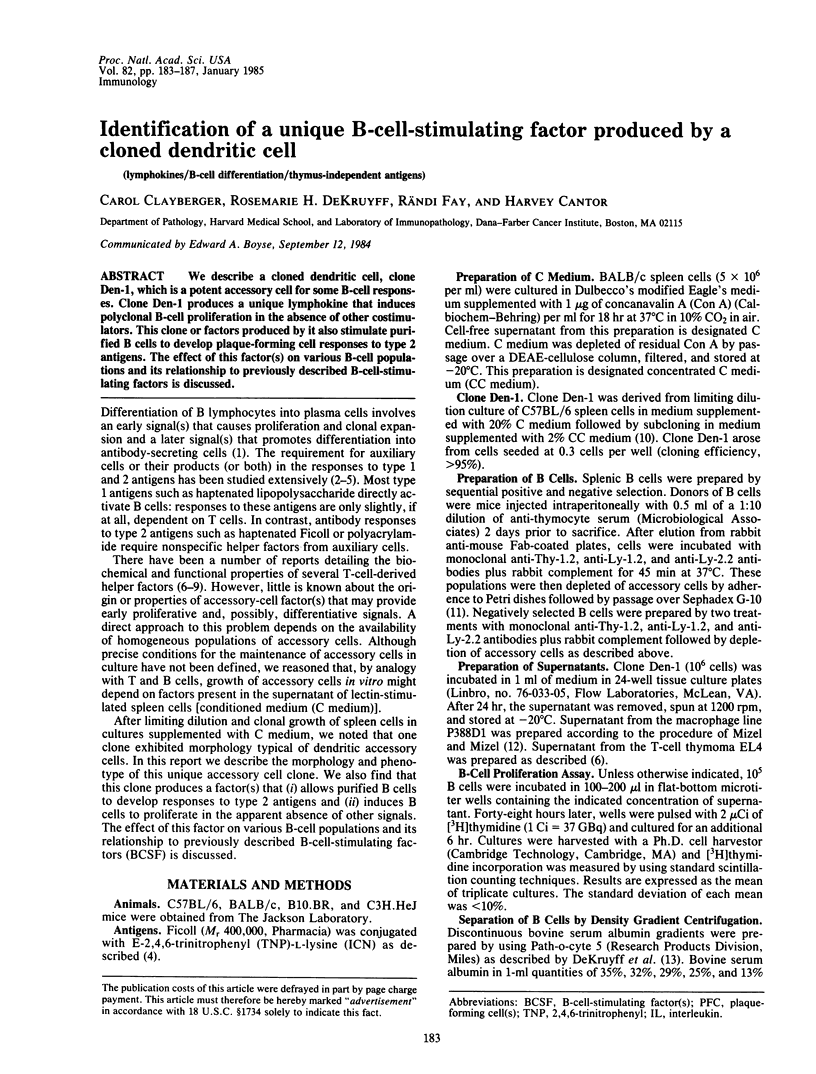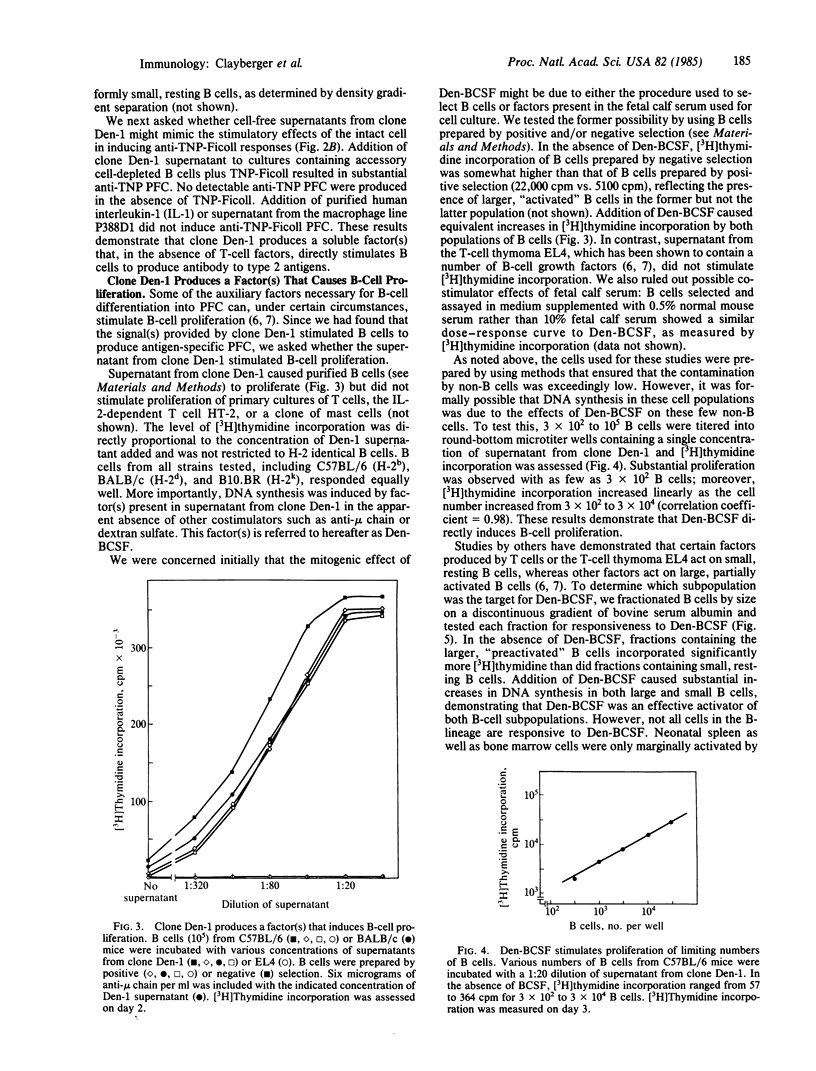Abstract
We describe a cloned dendritic cell, clone Den-1, which is a potent accessory cell for some B-cell responses. Clone Den-1 produces a unique lymphokine that induces polyclonal B-cell proliferation in the absence of other costimulators. This clone or factors produced by it also stimulate purified B cells to develop plaque-forming cell responses to type 2 antigens. The effect of this factor(s) on various B-cell populations and its relationship to previously described B-cell-stimulating factors is discussed.
Full text
PDF




Images in this article
Selected References
These references are in PubMed. This may not be the complete list of references from this article.
- Asano Y., Singer A., Hodes R. J. Role of the major histocompatibility complex in T cell activation of B cell subpopulations. Major histocompatibility complex-restricted and -unrestricted B cell responses are mediated by distinct B cell subpopulations. J Exp Med. 1981 Oct 1;154(4):1100–1115. doi: 10.1084/jem.154.4.1100. [DOI] [PMC free article] [PubMed] [Google Scholar]
- Booth R. J., Prestidge R. L., Watson J. D. Constitutive production by the WEHI-3 cell line of B cell growth and differentiation factor that co-purifies with interleukin 1. J Immunol. 1983 Sep;131(3):1289–1293. [PubMed] [Google Scholar]
- Clayberger C., Dekruyff R. H., Aisenberg J., Cantor H. Hapten-reactive inducer T cells. I. Definition of two classes of hapten-specific inducer cells. J Exp Med. 1983 Jun 1;157(6):1906–1919. doi: 10.1084/jem.157.6.1906. [DOI] [PMC free article] [PubMed] [Google Scholar]
- Dekruyff R. H., Clayberger C., Cantor H. Hapten reactive inducer T cells. II. Evidence that a secreted form of the T cell receptor induces antibody production. J Exp Med. 1983 Dec 1;158(6):1881–1894. doi: 10.1084/jem.158.6.1881. [DOI] [PMC free article] [PubMed] [Google Scholar]
- Dutton R. W. Separate signals for the initiation of proliferation and differentiation in the b cell response to antigen. Transplant Rev. 1975;23:66–77. doi: 10.1111/j.1600-065x.1975.tb00149.x. [DOI] [PubMed] [Google Scholar]
- Endres R. O., Kushnir E., Kappler J. W., Marrack P., Kinsky S. C. A requirement for nonspecific T cell factors in antibody responses to "T cell independent" antigens. J Immunol. 1983 Feb;130(2):781–784. [PubMed] [Google Scholar]
- Farrar J. J., Howard M., Fuller-Farrar J., Paul W. E. Biochemical and physicochemical characterization of mouse B cell growth factor: a lymphokine distinct from interleukin 2. J Immunol. 1983 Oct;131(4):1838–1842. [PubMed] [Google Scholar]
- Garchon H. J., Levi-Strauss M., Carnaud C., Bach J. F. Soluble factors for B cell activation: a T cell hybridoma that secretes a specific B cell growth factor. J Immunol. 1983 Feb;130(2):777–780. [PubMed] [Google Scholar]
- Howard M., Farrar J., Hilfiker M., Johnson B., Takatsu K., Hamaoka T., Paul W. E. Identification of a T cell-derived b cell growth factor distinct from interleukin 2. J Exp Med. 1982 Mar 1;155(3):914–923. doi: 10.1084/jem.155.3.914. [DOI] [PMC free article] [PubMed] [Google Scholar]
- Inaba K., Granelli-Piperno A., Steinman R. M. Dendritic cells induce T lymphocytes to release B cell-stimulating factors by an interleukin 2-dependent mechanism. J Exp Med. 1983 Dec 1;158(6):2040–2057. doi: 10.1084/jem.158.6.2040. [DOI] [PMC free article] [PubMed] [Google Scholar]
- Inaba K., Steinman R. M., Van Voorhis W. C., Muramatsu S. Dendritic cells are critical accessory cells for thymus-dependent antibody responses in mouse and in man. Proc Natl Acad Sci U S A. 1983 Oct;80(19):6041–6045. doi: 10.1073/pnas.80.19.6041. [DOI] [PMC free article] [PubMed] [Google Scholar]
- Lernhardt W., Corbel C., Wall R., Melchers F. T-cell hybridomas which produce B lymphocyte replication factors only. Nature. 1982 Nov 25;300(5890):355–357. doi: 10.1038/300355a0. [DOI] [PubMed] [Google Scholar]
- Liebson H. J., Marrack P., Kappler J. B cell helper factors. II. Synergy among three helper factors in the response of T cell- and macrophage-depleted B cells. J Immunol. 1982 Oct;129(4):1398–1402. [PubMed] [Google Scholar]
- Ly I. A., Mishell R. I. Separation of mouse spleen cells by passage through columns of sephadex G-10. J Immunol Methods. 1974 Aug;5(3):239–247. doi: 10.1016/0022-1759(74)90108-2. [DOI] [PubMed] [Google Scholar]
- Mizel S. B., Mizel D. Purification to apparent homogeneity of murine interleukin 1. J Immunol. 1981 Mar;126(3):834–837. [PubMed] [Google Scholar]
- Mond J. J. Use of the T lymphocyte regulated type 2 antigens for the analysis of responsiveness of Lyb5+ and Lyb5- B lymphocytes to T lymphocyte derived factors. Immunol Rev. 1982;64:99–115. doi: 10.1111/j.1600-065x.1982.tb00420.x. [DOI] [PubMed] [Google Scholar]
- Mosier D. E. A requirement for two cell types for antibody formation in vitro. Science. 1967 Dec 22;158(3808):1573–1575. doi: 10.1126/science.158.3808.1573. [DOI] [PubMed] [Google Scholar]
- Möller G., Lemke H., Opitz H. G. The role of adherent cells in the immune response. Fibroblasts and products released by fibroblasts and peritoneal cells can substitute for adherent cells. Scand J Immunol. 1976;5(3):269–280. doi: 10.1111/j.1365-3083.1976.tb00278.x. [DOI] [PubMed] [Google Scholar]
- Parker D. C. Separable helper factors support B cell proliferation and maturation to Ig secretion. J Immunol. 1982 Aug;129(2):469–474. [PubMed] [Google Scholar]
- Shortman K., Howard M., Teale J., Baker J. Antigen-initiated B lymphocyte differentiation. XVI. Primary and secondary adoptive responses involve two sequential stages, antigen nonspecific then antigen specific, in the generation of specific AFC. J Immunol. 1979 Jun;122(6):2465–2472. [PubMed] [Google Scholar]
- Shortman K., Palmer J. The requirement for macrophages in the in vitro immune response. Cell Immunol. 1971 Oct;2(5):399–410. doi: 10.1016/0008-8749(71)90051-7. [DOI] [PubMed] [Google Scholar]
- Sidman C. L., Paige C. J., Schreier M. H. B cell maturation factor (BMF): a lymphokine or family of lymphokines promoting the maturation of B lymphocytes. J Immunol. 1984 Jan;132(1):209–222. [PubMed] [Google Scholar]
- Steinman R. M., Cohn Z. A. Identification of a novel cell type in peripheral lymphoid organs of mice. I. Morphology, quantitation, tissue distribution. J Exp Med. 1973 May 1;137(5):1142–1162. doi: 10.1084/jem.137.5.1142. [DOI] [PMC free article] [PubMed] [Google Scholar]
- Steinman R. M., Nussenzweig M. C. Dendritic cells: features and functions. Immunol Rev. 1980;53:127–147. doi: 10.1111/j.1600-065x.1980.tb01042.x. [DOI] [PubMed] [Google Scholar]
- Swain S. L., Dutton R. W. Production of a B cell growth-promoting activity, (DL)BCGF, from a cloned T cell line and its assay on the BCL1 B cell tumor. J Exp Med. 1982 Dec 1;156(6):1821–1834. doi: 10.1084/jem.156.6.1821. [DOI] [PMC free article] [PubMed] [Google Scholar]
- Swain S. L., Howard M., Kappler J., Marrack P., Watson J., Booth R., Wetzel G. D., Dutton R. W. Evidence for two distinct classes of murine B cell growth factors with activities in different functional assays. J Exp Med. 1983 Sep 1;158(3):822–835. doi: 10.1084/jem.158.3.822. [DOI] [PMC free article] [PubMed] [Google Scholar]
- Thoman M. L., Weigle W. O. Identification and partial purification of a B cell growth-promoting material utilizing the BCL1 cell line. J Immunol. 1983 Jan;130(1):233–236. [PubMed] [Google Scholar]
- deKruyff R. H., Onikul S. R., Thorbecke G. J. Migratory patterns of B lymphocytes. V. Surface Ig and migration properties of density gradient-separated bursa cells. Eur J Immunol. 1976 Jul;6(7):462–467. doi: 10.1002/eji.1830060703. [DOI] [PubMed] [Google Scholar]




